Review: The NET Bible
This review has been relocated here:
http://thislamp.com/?p=98
Please continue any further discussion at the new location.
Lizards & Spiders & Targums, Oh My! [UPDATED]
It’s true-- check it out. Every major translation other than the KJV and NKJV contains lizard instead of spider:
Proverbs 30:28 |
|
| KJV | The spider taketh hold with her hands, and is in kings’ palaces. |
| NKJV | The spider* skillfully grasps with its hands, *Or lizard |
| RV/ASV | The lizard taketh hold with her hands, Yet is she in kings’ palaces. |
| RSV/ESV | the lizard you can take in your hands, yet it is in kings’ palaces. |
| NASB | The lizard you may grasp with the hands, Yet it is in kings’ palaces. |
| NIV/TNIV | a lizard can be caught with the hand, yet it is found in kings’ palaces. |
| JPS | You can catch the lizard in your hand, Yet it is found in royal palaces. |
| NRSV | the lizard* can be grasped in the hand, *Or spider |
| NLT | Lizards—they are easy to catch, but they are found even in kings’ palaces. |
| HCSB | a lizard* can be caught in your hands, *Or spider |
| NET | a lizard you can catch with the hand, but it gets into the palaces of the king. |
| NETS | and the lizard, though dependent on its hands and being easily caught, it lives in the king’s fortresses. |
So, of course I turned to Accordance. I opened up both the NASB and BHS Hebrew Bible modules side by side because I knew that I didn't know the Hebrew word for spider/lizard off the top of my head and the NASB has Hebrew tagging. After determining שׂממית/semamit was the word in question, I triple clicked on it to open the Hebrew and Aramaic Lexicon of the Old Testament (HALOT).

To double-check, I switched over to Brown-Drivers-Briggs Hebrew lexicon. It's still a lizard of some kind. Definitely not a spider.
So where in the world did the King James translators get "spider"?
I've come to the point in the last couple of years that when I want a quick answer to questions like that, I simply turn first to the NET Bible notes. Sure, commentaries are great for more in depth information, but the NET Bible notes have the answer in a nutshell--usually. I mean, normally there's an answer for everything in those 60K+ notes.
Sure enough, the NET Bible seemed to have it covered:
"The KJV, agreeing with Tg. Prov 30:28, translated this term as ‘spider.’ But almost all modern English versions and commentators, following the Greek and the Latin versions, have ‘lizard.’”
Okay, so this made a good bit of sense to me. The KJV Old Testament translators had a reputation for being very familiar with Jewish literature. Perhaps even the meaning of שׂממית was in question, and they turned to the Targums for answers.
For the curious, here is Prov 30:28 in the LXX and Latin as referred to in the NET Bible Note:
| LXX | καὶ καλαβώτης χερσὶν ἐρειδόμενος καὶ εὐάλωτος ὢν κατοικεῖ ἐν ὀχυρώμασιν βασιλέως |
| VULGATE | stilio manibus nititur et moratur in aedibus regis |
As expected, both the LXX and the Vulgate refer to a lizard (or a spotted lizard, or a gecko).
Now, I’ve got the Targums in Accordance as well, but I’ve never really used them much. In fact, I discovered in trying to look up Proverbs 30:28 that I didn’t even have the newest release. After installing the updated set of modules, I was able to look up the passage.
There is indeed a different word here, אקמת/’qmt. I couldn’t find the word in either Hebrew Lexicon, and it does not seem to be similar to the Hebrew word for spider (עכביש/‘akkavish). However, if I understand the nature of the Targums correctly, Proverbs was actually copied from the Syriac Peshitta. So, this really isn’t even Hebrew/Aramaic, but rather Syriac. And thus, this is really outside my language skills. Further, I don’t have an English translation of the Targum for Prov 30:28. However, the English gloss in Accordance for אקמת/’qmt is lizard.
Regardless I would be interested in further information. Perhaps Iyov (if you’re back from your travels) or John Hobbins might offer some insight.
UPDATE: As expected, Iyov provided helpful information in the comments:

I would find it a bit remarkable if the KJV used the Targums -- I do not believe they were expert in Aramaic, and Targum to Proverbs is a bit obscure even today.”
So it seems to me--at this point--that it may indeed be the NET Bible notes that are in error. The source for “spider” in the KJV & NKJV seems to be the medieval commentator Rashi, not the Targum on Prov 30:28, which according to the English gloss in Accordance, also uses a word for lizard, not spider.
Worthy of Note 01/30/2008
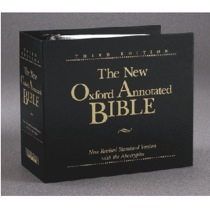
Says Iyov:
So, with all that extra page space, there is plenty of room for making ample annotations. The paper is significantly thicker than typical Bible paper, so there is much less bleed through from a pen. And, I can add extra paper anytime one wants (in the fashion of Jonathan Edwards' Blank Bible). If I make a mistake, I can always remove the page and replace it with a photocopy from my bound edition of the NOAB. If I want to slip in an entire article, or a copy of a page in original languages -- there is no problem. It seems to me that this is the ultimate in flexibility.
I'm glad to see this finally released, although I doubt I'll personally buy one. Regardless, I've got a number of larger blog projects I'm working on, one of which is an update to last year's survey of wide-margin Bibles. I'm glad that I'll be able to include an entry for the NRSV this year.

But we find ourselves at a point in history when we've never had so many choices, and yet the options are mostly arrayed along a horizontal spectrum -- a thousand different flavors of the same basic thing. I'd like to see more vertical choices, and that might require a shift in perspective. Instead of speaking to end-users as consumers, we might have to start thinking of them as readers.
What is most significant in the post is Bertrand's five-point "Starting Points for Marketing High-End Bible Editions." I can only hope that publishers will pay attention.


My esteem for White dropped significantly a few years ago due to the way he handled a theological disagreement with another individual whom I respect very much. I felt his approach to the issue was uncharitable, far too public, and lacking in the kind of collegiality that should characterize Christian scholarship. Nevertheless, White is usually in natural form when he is engaged in formal debate. However, I often believe that White is rarely pitted in his debates against opponents who are equally skilled. At the very least, Ehrman should provide a worthy opponent to White and this is a subject in which both are well-versed.
Christianity Today has released its list of the "10 Most Redeeming Films of 2007." Some entries on the list may surprise you, but it's a very good list. I remember when we used to do more movie reviews and discussion around here.
Finally, in the I JUST DON'T GET IT DEPARTMENT: 2008 marks the 30th anniversary of the New International Version of the Bible. I've seen references on two other blogs (see here and here; oh, and also here) that Zondervan is planning a special wide-margin, high-end leather edition of the NIV Study Bible as one of the many ways that the NIV's 30th anniversary will be celebrated.
This is in spite of the fact that so many of us have asked for one decent wide-margin edition of the TNIV (the so-called TNIV Square Bible is flawed in three areas: (1) it's paper is too thin for annotations because it is a thinline, (2) the user doesn't have wide margin access to the inner column of text, and (3) the binding is subpar). If the TNIV is truly an improvement to the NIV (which I honestly believe it is), then why does Zondervan (and IBS, Cambridge, and Hodder) keep pushing the NIV and publishing new editions? If in ten years the TNIV turns out to be an also-ran translation, it will only be because publishers didn't know how to fully transition away from the NIV.
My suggestion for celebrating the NIV's 30 year anniversary? Retire it. (My apologies to everyone I just offended, including my friends at Zondervan.)
I would like to find simply ONE decent wide-margin, high quality (see Bertrand's post above for the meaning of high-quality) Bible in a contemporary 21st century translation (HCSB, NLTse, TNIV, or NET). I'm still writing down notes in my wide margin NASB95, but the first translation of those I've listed that is released in a single-column, non-thinline, wide-margin edition, I will make my primary translation for preaching and teaching for the next decade. You heard it here first.
Plural "You" in John 1:51

My third point, drawn from John 1:47-51, I labeled "Be ready for the unexpected." In my initial study of this passage, I noticed that in the Greek that in v. 51 Jesus shifts from simply addressing Nathaniel to addressing other disciples who were presumably present. Translating a plural you into English can be a bit tricky since we technically don't have a separate word in standard English for the second person plural. A fairly literal translation of this verse would read something like this:
And he said to him, "Truly, truly I say to y'all [ὑμῖν], y'all will see [ὄψεσθε] heaven open...
Of course, I can translate with y'all because I grew up in the south. And I should also mention that the KJV communicates the second person plural (at least clearly in the second instance) because Elizabethan English also allowed for the distinction by using the now archaic ye:
And he saith unto him, Verily, verily, I say unto you, Hereafter ye shall see heaven open (John 1:51 KJV)
Regardless, when there is a shift of person in the Bible such as that in v. 51, I readily admit that it's not always significant. But here I believe it is. Jesus' message of what a disciple would experience was not something meant for Nathaniel alone. A few translations make an effort to represent the second person plural, but most traditionally have not. Originally, I had been planning to use the NLT for this message, not only because I believe it communicated the entire passage well, but especially because it brought out the plural "you" here:
Then he said, “I tell you the truth, you will all see heaven open... (John 1:51 NLT)
However, then on Friday, I received my copy of the NET Readers Bible in the mail. Looking at the passage and especially v. 51, I was pleased to see the second person plural rendered here as well:
He continued, “I tell all of you the solemn truth–you will see heaven opened... (John 1:51 NET)
Thus I began my little "NET for a month" experiment and preached from it on Sunday.
I should point out that a number of other translations mention the plural "you's" in the footnotes, including the ESV, HCSB, NRSV, NIV and TNIV. The REB is another translation that renders the plural in the actual text.
So which is better: text or notes? I would suggest that the better rendering is when it can be done in the text for the sake of those listening without a Bible in front of them.
Feel free to leave your opinion in the comments.
NET for a Month

I’m doing this so that I can get to know the translation better. When I wrote my Top Ten Bible Translations series, I included the NET Bible in my honorable mentions but not in my top ten. Like most who are familiar with the NET, I’ve been very impressed with the inclusion of the 60K+ notes in the regular edition, but I’ve never spent a whole lot of time with the translation itself. I’ll confess that my limited amount of time with the NET has made me think the translation is a bit flat at times, kind of like the original NIV. However, this may be an unfair assessment since as I have said, I really have not spent enough time with it to give the NET translation a fair evaluation.
I’d been planning this little experiment for a while, but today I received in the mail a nice top grain leather edition of the Reader’s Edition of the NET sent to me by Mitch Guthrie who works with Bible.org. This is a really nice edition of the NET Bible, with only about 10% of the full notes, but fits in the hand quite well. It has a very readable print size and mercifully, it’s not a thinline. [Thanks again for the Bible, Mitch.]
So, in an attempt to become better friends with the NET, I am going to attempt to use it as a primary (but not exclusive) translation over the next month or so. That means when I leave the house, I’ll take the NET Bible with me. I’ll use it for teaching as well as preaching (I’m filling in for my pastor day after tomorrow) and I’ll use it in my IWU classes for our devotionals. As I often bring along a Greek NT in my book bag, too, I’m going to take the NET Diglot instead of the normal Greek NT I carry.
Although my top ten series is over, I promised to continue reviewing Bible translations. So after my 30 days or so with the NET Bible, I’ll post a full review along the same kind of format as my earlier reviews. Look for this sometime in September.
Missing My Wide Margin NASB
Frequent readers of This Lamp will remember that although I've always been an aficionado of Bible translations, I used the NASB for almost two decades in teaching and preaching settings until I became convicted a couple of years ago that the formality and literalness of the translation itself was getting in the way of what I was trying to teach. Since then, I have primarily used the TNIV in public, but I've also used the HCSB and NLT to a certain extent as well. And often even when needing to carry a translation to a setting where I wasn't presenting, I tended to pick up my TNIV.
But yesterday is a good example of this "change" in my habits. I've been meeting a friend of mine for breakfast for a couple of years now, and we usually read a book together and discuss it over bagels. Over the last few weeks we've been reading Bonhoeffer's Cost of Discipleship. Yesterday as I was heading out the door to meet for breakfast, I grabbed a Bible as I always do. But instead of grabbing the TNIV Study Bible which has been my practice for a few months, I picked up my wide margin NASB.
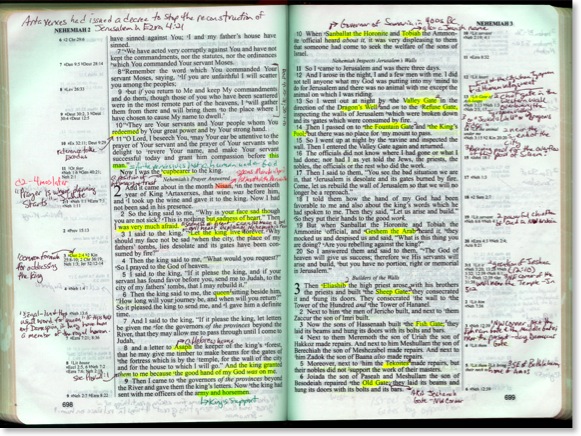
Doesn't the TNIV Study Bible have notes? Sure it does. But the notes in my NASB are my notes. These notes are the facts and insights that stuck out to me. These notes are the triggers I used to discuss the text when I was teaching it last. The TNIV Study Bible is the first study Bible that I have ever consistently carried with me. It's notes are helpful, but I find that I don't automatically turn to them. I look at them if I need to look something up and hope that the information I need is there.
After using other Bibles for over a year and a half now, I have to admit that i really miss my wide margin NASB. And I don't think it's the NASB that I miss so much, although I will always have a great familiarity with it. What I miss is the ability to refer to my notes, to refer to a tangible experience of having spent time--studied and wrestled--with a particular passage before. I don't have notes on every page of my Bible. But the notes that I do have are footprints that I was there, evidence that I stopped and camped out a while, as opposed to merely passing by.
I stay in a continuing conundrum. I really do feel committed to public use of a contemporary translation. And I would prefer a gender-accurate, non-Tyndale translation when presenting in front of mixed audiences. But no usable wide margin edition of a contemporary translation exists that meets these factors. There is no wide margin NLT and the only wide margin TNIV offering limits writing space to one column on a two column page and has paper too thin for extensive use. I might be willing to settle for the HCSB even though it is not gender accurate, but the pages in its only wide margin offering are so thin that they curl when writing on them.
At this point, I would like a new wide margin Bible (leather, of course) in a contemporary translation--any translation. I'm willing to transcribe my notes even a third time. TNIV? NLT? NET? HCSB? Something else? At this point, I'm not even overly concerned with the exact translation, in spite of the fact that I have my personal favorites and feel some are better suited for teaching than others. Whichever publisher first delivers a wide margin edition in one of these translation wins--at least with me.
Every Sunday morning when I leave for church, I push aside my wide margin NASB in favor of the TNIV Study Bible. Despite the fact that as I've studied a passage that I will be teaching I've taken diligent notes in the margins of my NASB, I've been forced to create a subset of these notes in the anemic margins of the TNIV Study Bible or in whatever white space I can manage. But the temptation to grab my trusty NASB and run remains. And I wonder if this temptation is growing stronger?
iPhone Bible App Roundup: 08/09/07
About three weeks have passed since I wrote my first iPhone Bible app roundup. Yet in that very short span of time, four new iPhone Bible offerings have been made available. In this post I will offer short reviews of each of these apps.
While looking at these apps, I began to notice some similarities in interfaces. I discovered that a number of them are based on the "iPhone User Interface" (iUI) created by Joe Hewitt. This interface is similar to the color and design of some of the Apple-based apps on the iPhone such as the Mail app and the list view in the iPod app. Of course, it's not just Bible apps that are using the iUI; a quick look at the iPhone Application List shows that lots of folks are using it. This is in spite of the fact that Hewitt himself has called the interface a bit boring. Personally, I like the simplicity of Hewitt's interface because I immediately know how to use any app created with it.
Also, I want to point out that although I used screen captures from my MacBook for the last roundup, from this point forward, I will be using a camera to take pictures of the screen to give a better idea of what these apps look like on an actual iPhone (with one exception below). The downside of that is that the images will not be as clear as the previous ones. That is not to say that these apps are not clear on the actual iPhone, but rather that it is just extremely difficult to take a picture of the screen on an electronic device. I did finally figure out that I should turn off my flash though.
iPhone Bible (NAB)
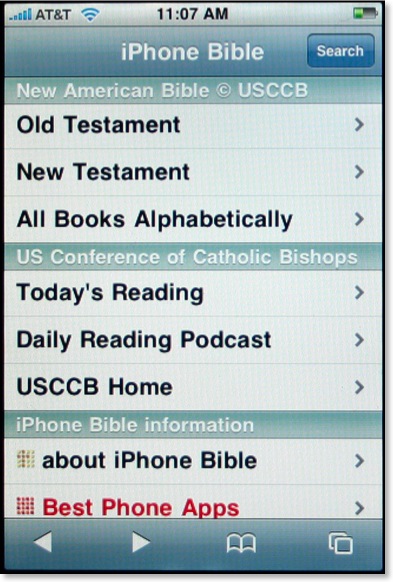
I was initially intrigued when I first heard of the iPhone Bible (does this mean they now have control of that name?) because it would be the first iPhone Bible app to include the deuterocanonicals/apocrypha. Using Hewitt's aforementioned iUI, the opening screen of the iPhone Bible is both clear and colorful. Using a similar method we've seen elsewhere, the user selects Old or New Testament, which leads to the appropriate books of that testament (plus preface and section introductions), chapter numbers, and finally the full text of the selected chapter. That's where the surprise comes.

The biblical text for the iPhone actually comes from the already existing NAB pages from the United States Council of Catholic Bishops website. What that means is that these pages are not already formatted to a mobile device such as the iPhone and as demonstrated above, can be barely read at first. To see the text better, the user has two options. First, the iPhone can be turned sideways:
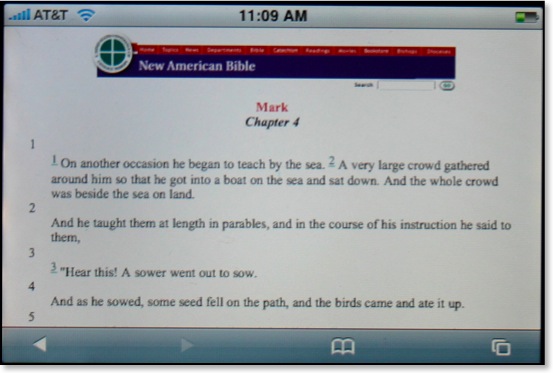
This is helpful, but still not a perfect solution. Another option of course is to simply do the iPhone multi-touch pinch resulting in text as large as desired:
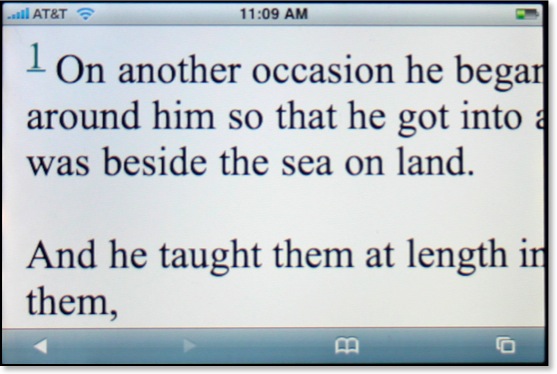
Yes, Steve said we'd have the actual internet on the iPhone, but it's not always as practical as it sounds. Even with the text enlarged, this is still not an ideal solution for reading large sections of Scripture as one would constantly have to move the page around to see the entire text.
The NAB iPhone Bible is a great idea, but it suffers from the inherently small text that renders from the original USCCB pages. There is no search function built into the iPhone Bible, but there is a search available upon arriving at the USCCB pages. However, the user will want to restrict searches to the entire Bible because by default the entire site is searched. This was certainly a good idea, but perhaps the developers could get permission to reformat the NAB text specifically for the iPhone and other mobile devices.
The Net Bible
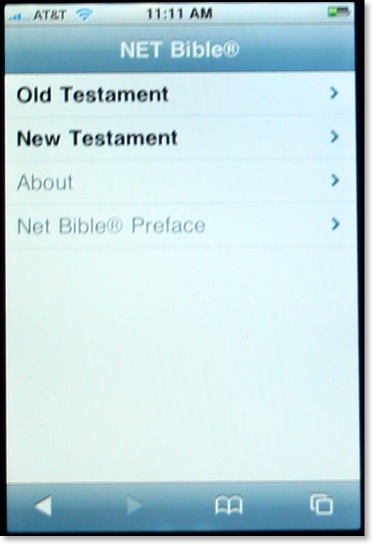
Soon after I got my iPhone, I thought to myself how incredible it might be to have the NET Bible with all 60,000 notes literally in the palm of my hand. I contacted the folks at Bible.org to suggest they offer a NET Bible iphone app, but they were already well ahead of me as they had already been considering the very same thing. The NET Bible for the iPhone also uses Hewitt's iUI, and the navigation to a particular passage of the Bible is similar to the one described above.

In my last set of reviews, I praised iBibleSpace for the best interface of any iPhone Bible app so far. That evaluation remains so far, but I can say that the NET Bible has the best layout of text of any of the Bible apps so far. Not only are all formatting features (italics, bold, etc.) retained from the original NET Bible, but also the text is large and not crowded. There are spaces before and after section headings so that the text does not run together. Note the blue numbers above. These are links to the NET Bible's 60,000+ textual notes. The folks at Bible.org have thought through the implementation of these notes quite well because when the user seeks to access the NET notes, an entirely separate page is launched. This allows the user to flip back and forth between the text and the notes without having to wait for a page to load from the internet.
However, a current limitation of the iPhone causes a problem in the NET Bible notes as well. Compare these two screens below--notes from Gen 1 on the left and Mark 4 on the right:
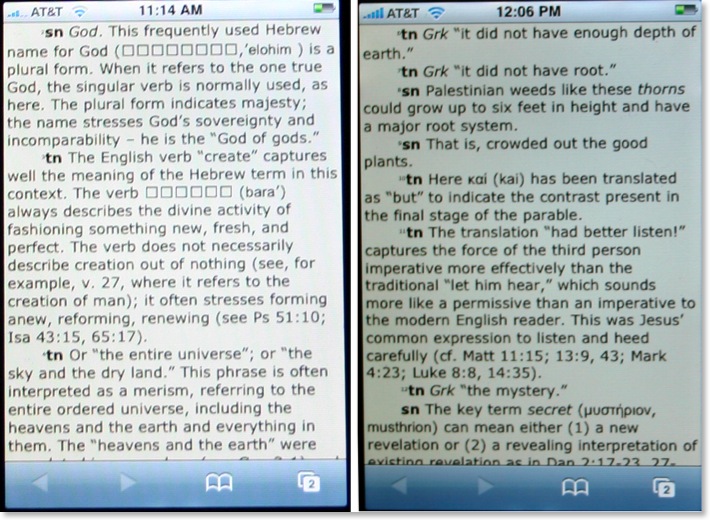
[Note: the actual screens of the NET Bible notes are the same color. The images above just reflect my poor photography skills.]
As I mentioned in a previous post, Hebrew does not show up correctly yet on the iPhone. So notice on the left image which contains notes from Genesis 1, that square boxes appear where Hebrew text displays in the original. There are other places where the boxes show up in place of Hebrew, such as the section headings in Psalm 119 and references to Sinaiticus in the NT notes. However, on the right screen, with notes from Mark 4, the Greek word μυστήριον appears correctly. I would recommend to the NET Bible team that for right now they do nothing to "fix" this text. The iPhone will have to include Hebrew as the phone is marketed internationally. One would assume that the addition of Hebrew and other international fonts will be included in a later iPhone software update. I should also point out that the since I took these shots, the superscript numbering at the beginning of each note has been enlarged.
The NET Bible on the iPhone will no doubt be very beneficial to many iPhone users, including myself. Like a lot of these apps, there's no search feature as of yet. I might also throw out a challenge to the programmers to create a window that has the biblical text on top and the notes on bottom (or side to side if the phone is turned). Regardless, this is a good and needed beginning.
God's iPhone (GWT)
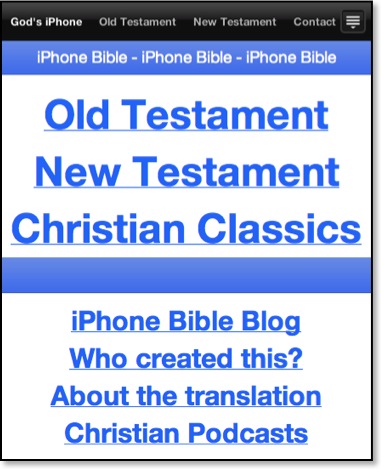
[Note: the above image was taken as a screenshot off my MacBook because the opening screen has changed so dramatically since I first took my photographs.]
God's iPhone was created by Israel Anderson of New Zealand. This Bible app uses the lesser known, but still very good, God's Word Translation of the Bible. This project is not yet complete, but so far, Anderson has made available the entire New Testament and parts of the Old Testament (Genesis, Exodus, and Psalms). Also Anderson has added a section for Christian classic (presumably public domain) works. The first entry made available is A. W. Tozer's Pursuit of God.
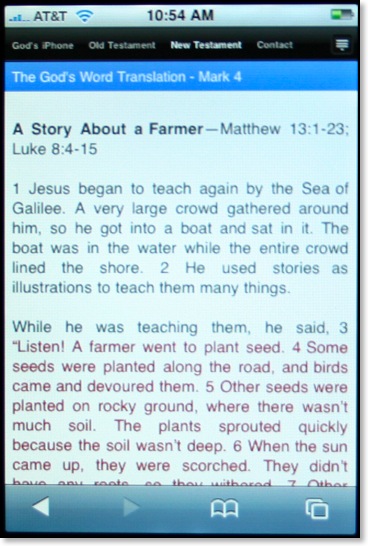
I'm assuming that Anderson has used RapidWeaver's new iPhone template for his Bible app. As a RW user myself I've played around with this template in hopes of eventually offering a Greek NT for the iPhone (but I'm not sure how legal this is since the NA text is copyrighted). The RW iPhone template includes a drop down menu seen in the icon at the far right of the image above. Anderson has opted not to take advantage of this leaving all menu items on the screen. This is just as well because I've found it difficult to make selections with this menu in my own tests.
As seen in the image above, text is clear and well spaced, but I can't help thinking it would be easier to read if the text were not displayed using full justification. Studies have shown that full justification, while looking neat and orderly, is actually harder to read because it makes it harder for the eyes to find the next line.
Regardless, God's iPhone has an easy to use interface and has the distinction of being the only way to view the GWT on the iPhone. There is no search function yet, but it is still a work in progress.
ESV Mobile

I've found the community of ESV users to be quite savvy when it comes to the internet and most things technological. They tend to be forward thinking and embrace new technologies quicker than those who sponsor competing translations of the Bible. Crossway, the publisher of the ESV has updated their mobile site making it more iPhone friendly. This now makes three separate iPhone apps that use the ESV (iBibleSpace uses the ESV by default and 3onesix allows for the ESV by including the abbreviation before a search). Crossway is distinguished as being the first major Bible publisher as of this writing that has offered a method of reading the Bible to iPhone users.
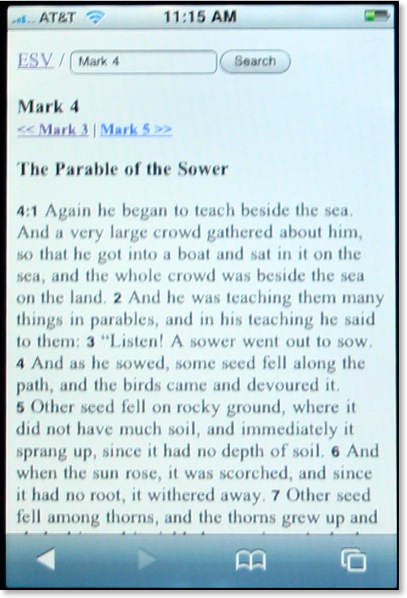
A very helpful feature of the ESV Mobile site is the inclusion of a search feature on every screen. The text is formatted with plenty of space, perhaps even better than iBibleSpace which tends to run headings and text together and use a verse by verse format. Oddly however, the text itself when viewed on the iPhone is serifed in spite of the fact that when I look at it on my MacBook it is sans serifed. I'm not sure what font is being used, or if one is specified at all, but I would think a sans serifed font like Arial or Helvetica would be much easier to read not only on the iPhone, but other mobile devices as well.
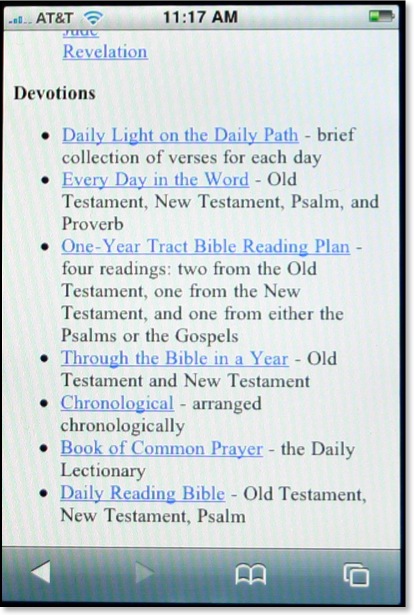
The ESV Mobile site also offers a variety of daily devotionals/readings as well. Like I said in my review of iBibleSpace, I can't imagine reading a devotional from my iPhone (or even a full daily reading of the BIble), but others may be more so inclined.
If you hear of an iPhone Bible app, or an iPhone app related to biblical studies, be sure to let me know and I'll mention it here on This Lamp.
Comparing Apples to Pupils: Zechariah 2:8 in the HCSB, NET, and NLT
also all Hebrew below has been transliterated as RapidWeaver seems to continue to have difficulties correctly rendering Unicode Hebrew]
I've stated on a number of occasions how much I respect the HCSB translators' decision to regard accuracy over tradition in many of the translation's renderings. In my review last year of the HCSB, I remarked that although the HCSB courageously breaks with traditional wording of a favorite verse like John 3:16, it does so strictly for the sake of better communicating the meaning of that verse which is easily misunderstood in most translations.
And so it is with Zech 2:8 which was part of our Bible study yesterday at church.
Zechariah 2:8 |
|
Traditional Renderings |
Accurate Renderings |
| For thus saith the LORD of hosts; After the glory hath he sent me unto the nations which spoiled you: for he that toucheth you toucheth the apple of his eye. (KJV) | For the LORD of Hosts says this: “He has sent Me for |His| glory against the nations who are plundering you, for anyone who touches you touches the pupil of His eye. (HCSB) |
| For this is what the LORD Almighty says: “After the Glorious One has sent me against the nations that have plundered you—for whoever touches you touches the apple of his eye— (TNIV) | For the LORD who rules over all says to me that for his own glory he has sent me to the nations that plundered you–for anyone who touches you touches the pupil of his eye. (NET) |

Using Accordance, I scanned the KJV to determine that this translation uses the English word apple for four separate Hebrew words in the OT:
- ’ishwon: Deut 32:10; Ps 17:8; Prov 7:2
- tappuach: Song 2:3; 8:5; Joel 1:12
- vat: Lam 2:18
- vava: Zech 2:8
If anything, "apple of his eye" seems to communicate something slightly different in our culture than what was intended in the text. I did a quick survey of my class yesterday as to the meaning of "apple of his/my eye" and most responses were of the "cutesy" variety, often noting the idea of a daughter being the apple of her father's eye.
In Zech 2:8, vava literally means "gate" of the eye; but ultimately, that's too literal for understanding in English. The meaning here is essentially the pupil as the HCSB and NET correctly translate it. McComiskey notes:
In this analogy, the eye is Yahweh's [...] As the eye is extremely sensitive to touch, so God is sensitive to what threatens his people. The statement develops further the important postexilic theme that God will protect his people and allow no hostile intervention. (The Minor Prophets, vol. 3, p. 1061)
In other words, to mess with God's people is like poking a stick in God's eye, so watch out!
One more note: the NLTse translation of Zech 2:8 bypasses the apple/pupil issue to focus on the meaning of the phrase:
After a period of glory, the LORD of Heaven’s Armies sent me against the nations who plundered you. For he said, “Anyone who harms you harms my most precious possession.
But more important than that, of all the most recent translations, only the NLT attempts to correct the tiqqune soferim found in this verse. That is, the ancient Hebrew scribes were offended at the idea of poking a stick in God's eye, so the wording was changed from "my eye" to "his eye." Thus, in the end, according to one's opinion and evaluation of the dynamic rendering "my most precious possession," the NLT may turn out to be the most accurate translation of Zech 2:8 of those surveyed here.
For another look at a tiqqune soferim, see my post on Hab 1:12.
Top Ten Bible Versions: The Honorable Mentions
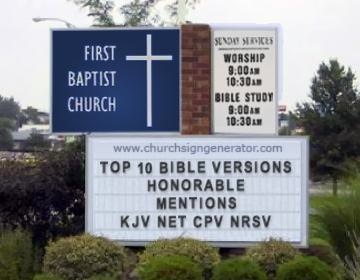
In hindsight, I don't know if the "Top Ten" designation was all that accurate because these aren't the ten Bibles I use the most. But in addition to the first few which I actually do use a good bit, I also wanted to introduce a few other translations that have stood out to me over the past couple of decades since I began collecting them. There are a few other Bibles that were contenders for such a list. I thought that I could briefly mention them in this follow up post.
King James Version.
I would imagine that if most people put together a top ten list, the KJV would be on it. I almost included it, but it seemed too predictable. Plus, I'm in no position to necessarily write anything new on the KJV (not that my other posts were wholly original either). Nevertheless, the KJV does deserve recognition because no other English translation has held the place of prominence that it has in the history of translations. It is still used today as a primary Bible by millions of Christians, still ranks somewhere in the top three positions of sales in CBA rankings, and even for those who have moved onto something newer, it is still the translation that verses have been memorized in like no other version.
I predict this is the last generation in which the KJV will still receive so much attention, but I have no trouble saying I may be wrong. It's difficult to say that one can be reasonably culturally literate--especially when it comes to the standards of American literature--without a familiarity of the KJV. Nevertheless, I cannot in good judgment recommend the KJV as a primary translation for study or proclamation because its use of language is too far removed from current usage. I don't mean that it's entirely unintelligible--not at all. But a primary Bible should communicate clear and understandable English in keeping with the spirit of the Koiné Greek that the New Testament was written in. I also cannot recommend it as a primary Bible because of the manuscript tradition upon which it rests. There's simply too much that has been added to the text. It was certainly the most accurate Bible in its day, but this is no longer true. My exception to this, however, is that I do find the KJV acceptable for public use with audiences made up primarily of senior citizens since this was exclusively their Bible. And the KJV still seems to be appropriate for use in formal ceremonies including churches and weddings--although I have not recently used it for such.
There is some confusion on what is actually the true King James version. Most do not realize that the average KJV picked up at the local book store is not the 1611 edition, but rather a 1769 fifth edition. And the reality is that there are numerous variations of this out there. For those who want a true and unadulterated KJV, the recently released New Cambridge Paragraph Edition seems to be the one worth getting.
The NET Bible.
The NET Bible is one of about four translations (including the ESV, NRSV, and KJV) of which I received the most emails asking why it wasn't included in my top ten. The primary initial reason for the NET Bible's exclusion was simply that I had not spent enough time with it. I made the unfortunate decision to purchase a "2nd beta edition" only a few weeks before the final first edition came out (of which I recently obtained a copy).
Everyone I've heard speak about the NET Bible has high remarks about the 60K+ notes that come with the standard edition. And I can honestly say that these notes have become a regular resource for me when I study a passage. I don't hear as much high praise for the translation itself, though I don't hear anything particularly negative about it either. In general, though, I do recommend the NET Bible. I really like the editions I've seen made available--not just the standard edition, but also the reader's edition, and the Greek/English diglot which I'm very impressed with. The notes in the diglot are a slightly different set than what is in the standard edition. The "ministry first" copyright policy and the ability to download the NET Bible for free from the internet are very commendable on the part of its handlers.
I'd like to see the NET Bible get more attention, and I'd like to see more people introduced to it. I'm not sure it will get the widespread attention it deserves as long as it can only be obtained through Bible.org. In spite of the fact that my top ten series is over, I am going to continue to review translations, and the NET Bible will probably receive my attention next. But we have to spend some quality time together first.
The Cotton Patch Version.
I decided not to include a colloquial translation in my top ten, but if I had, the Cotton Patch Version of the New Testament would have held the category. Most colloquial translations are fun, but a bit gimmicky. The Cotton Patch Version rendered from the Greek by Clarence Jordan was anything but gimmicky. During the height of the Civil Rights Movement in the 1960's, Jordan recast the events of the New Testament in the Southern United States. Replacing Jew and Gentile with "white" and "negro," and status quo Judaism with Southern Baptists (of which he was one), Jordan clearly brought the radical message of the New Testament into current contexts. The Cotton Patch Version is certainly fun reading if you are familiar with Bible Belt southern locales, but more importantly, the message is gripping as well.
The New Revised Standard Version.
The NRSV is an honorable mention I've added since I first announced the series. Originally, I felt like the NASB represented both the Tyndale tradition and formal equivalent translations well enough, plus at the time my use of the NRSV had become quite rare. Then my little NASB vs. NRSV comparison that I wrote with Larry revived my interest in the NRSV, and I now even have a copy sitting on my desk.
A year ago, I would have thought that the NRSV had seen its last day in the Bible version spotlight--except for academic use, but it seems to have had a bit of a renaissance with new attention and even new editions being published. It is still the translation of choice for the larger biblical academic community, primarily in my opinion because it has the widest selection of deutero-canonical books available of any translation. In its early days the NRSV was also embraced by many in the evangelical community but such enthusiasm seems to have waned. I think than rather than fears of theological bias, evangelical readers simply have too many other versions to choose from since the release of the NRSV.
Yes, the NRSV may be a few shades to the left of evangelical translations, but I've spent enough time with it to state clearly that it is not a liberal Bible. Don't let sponsorship from the National Counsel of Churches drive you away. If that were the only factor in its origin, I'd be skeptical, too, but the fact that Bruce Metzger was the editorial head of the translation committee gives me enough confidence to recommend it--if for nothing else, a translation to be read in parallel with others.
Well, is the series done? Not quite yet. I'll come back later this week with a few concluding thoughts about the list and the current state of Bible translations in general.
The Grantham Bible Study Method
A Guest Post by Chuck Grantham
Rick has asked me to expand a bit on how I prepare for Sunday School for those who may not read the comments section.
The first thing I should say is that I do not teach a Sunday School class. I do this primarily for myself. On the other hand, I think any group of believers studying the Bible deserve good answers when they have questions, and the Learner Guide in the Lifeway Explore the Bible series, the Southern Baptist Convention’s Sunday School quarterly, cannot possibly address all the questions that can come up in your average class.
It is also a help to the actual teacher when someone can give a quick answer to those odd, even off-topic questions that come up, so the teacher can get back on topic. You culprits know who you are….
I should also add that this is a new routine for me, and is slowly evolving as I use it. It also varies a bit depending on the genre of the biblical book we are studying. For Old Testament history I do more historical study and less textual work because my Hebrew and my resources aren’t up to it. For the Gospels I do more synoptic comparison and non-canonicals research, because that‘s a scholarly trend right now and I am fascinated by the agrapha, even if Craig Evans dismisses it.
So as they say, this is where I am at right now, in regard to Sunday School preparation. Here are the steps as I can best outline them:
1. Read the lesson passage in the Learner book.
Of course, you’ve got to read the text first. This can involve different amounts of material. The lesson starts off with a title and then two sets of verses:
A) Background passage: the length of material assumed necessary to grasp the context of the lesson.
B) Lesson passages: those verses actually studied and commented upon in the Learner book.
Sometimes the background passage and the lesson passages are the same. Sometimes the background is several chapters and the lesson passages are the highlight verses within the background passage. My strong suspicion is most folk only read the lesson passages, and even that only in the translations provided in the Sunday School book.
Yes, I said translations. The Explore The Bible Learner Guide provides the lesson passages in side by side renderings from the Holman Christian Standard Bible and of course, the King James Version. This selection leads us to my next step.
2. Check HCSB and KJV for obvious differences.
I love parallel Bibles. But they can confuse someone who does not understand the background of translations. Not only do different Bibles read differently because of different translation philosophies (mirroring the original text versus mirroring contemporary speech of the translation‘s day, to grossly simplify) but also because translations are based upon different “original” texts. Speaking strictly of the New Testament, Older Roman Catholic Bibles were based upon the Latin Vulgate, which varied in places from the King James Bible, based upon Erasmus’ Greek New Testament. And both vary again from Bibles published in the last 130 years, when discoveries of massive numbers of Greek, Latin, Coptic, Syriac and many more language new testament manuscripts have led scholars to create several “standard” Greek New Testaments, which has further led to each new translation’s translator(s) being forced to decide in numerous places which Greek wording seems more original to them.
All of which is to say that the HCSB and the KJV do not always agree, and not only because centuries separate the vocabularies of the two. The venerable old KJV is based on Greek manuscripts from the Middle Ages, which tend to be more verbose in fear of leaving something good out. The HCSB is based on the current scholarly Greek New Testament, which tends to follow the earliest well-produced manuscripts, whose scribes had not yet added wordings to make things clearer or more reverent, and thus tends to be shorter.
So, after reading the HCSB and the KJV, I do a comparison of their wording, and I take a pen and circle the differences I see, either in vocabulary or in text. That gives me a series of verses which I can then use as a guide for the next step.
3. Check NET diglot for textual notes.
This is the first step where level of education rears its head. I personally have what might be described as “word study Greek.” I can read Greek letters and I know a lot of root words in the vocabulary. Thus I can use certain tools an English-only reader cannot. There are tools for the Greek-impaired to do these sort of things, too, though.
For those with Greek or without, the NET Bible First Edition is a great help, if you don’t let yourself be intimidated. With over 60,000 notes (compared to many study Bibles’ 20,000 notes) the NET is either a study Bible on steroids or an emaciated commentary. Besides the inevitable complaints about its translation philosophy, the NET’s chief strength is its greatest weakness: it has notes for every level of user. Simple definitions of terms sit alongside lengthy discussions of textual critical issues using manuscript numbers and Greek wording. Transliterations are provided as well as notes with “literal” translations of phrases, though.
My preferred edition of the NET when dealing with the New Testament (and we Christians usually are) is the NET Diglot. That is, a parallel Bible with the Nestle-Aland 27th (NA27) edition of the Greek New Testament combined with the NET English translation and notes. Why? Because I am a hopeless New Testament textual criticism geek. Reading the New Testament in Greek for most will simply confirm how careful most translations are to get things as right as they can. And because inevitably translators use
the same reference books and read each other’s translations, a good parallel English New Testament will reveal strong similarity in most Bible passages. But when they do differ, there is no better one stop resource than the NET diglot, which combines the mini-encyclopedia of the NET with the second mini-encyclopedia of the NA27, which endlessly footnotes even minor variations in the wording of NA27’s Greek text by citing which important manuscripts differ from the NA27, then which ones agree with NA27, then which important previous editions of the Greek New Testament agree or disagree with NA27. All of this together with an appendix citing the approximate age of the important manuscripts and what text of which New Testament books they contain.
All this can make for information overload, and the chief complaint against NA27 is that it requires one to learn practically another language in the form of NA27’s symbols and abbreviations to truly use it well. There are two solutions to this:
a) NET Diglot comes with a little foldout containing the witnesses, signs and abbreviations used in the NA27 that will be constantly in readers’ hand.
b) NET footnotes on the opposite page contain English sentences stating as simply as possible much the same information as abbreviated in the NA27 footnotes.
So, having found out what the NET Diglot says about the differences between HCSB and KJV, I will usually circle or underline the variation in the Learner book, draw a line out to the margin of the page, and write out a transliteration of the Greek, together with the earliest manuscript or two supporting each variation with rough date.
At this point I will also be mulling over other things I have learned from the footnotes on the NET side of the diglot, which I will have noticed mentions literal translations, other text critical issues, or even translation issues. But now it is time to go back to the Learner Guide for the next step.
4. Read the passage overview in lesson book, noting where the author keys on words, provides definitions or parallel verses.
In other words, grill the author on the assertions he makes. If he defines a word, I’ll circle it, find the Greek term in the diglot, see how NET translates it, and if I’m at all suspicious of the English term, walk over to my book case and pull out my copy of The New International Dictionary of New Testament Theology: Abridged Edition
Key words and parallel verses require more work and more tools. I will cross check the English against the Greek so I get one term, then for the key words simply see how often they are repeated in the Greek text. I do this with E-sword, the excellent FREE (mostly) Bible software. By simply highlighting the Greek word and clicking, I can run a search on the word in the current book or the New Testament. With a copy, a switch to the LXX, and a paste, I can further search for the word in the Old Testament. Even with my poor Greek, I can flip through English versions in E-sword and get a sense of the range of meaning for the word, and very often discover parallels to my New Testament text.
If this doesn’t satisfy me (and by now you realize I’m not easily satisfied) I can hit the books again. Specifically Goodrick, Kohlenberger and Swanson’s The Exhaustive Concordance to the Greek New Testament
This is the point scratch paper comes in handy. Among these many verses I will make note of the parallels quoted in the Learner book and my search I find significant. That leads me to the next step.
5. Significant parallels I paste together and print out in Greek and English, particularly where outright quotes from LXX or a usage determining a discussed word meaning occurs.
Simply put, I’ll cross check my scratch list, pick the most important, then make a file of the New Testament and Old Testament parallels in Greek and English which I resize as small as readable, then print up double-sided to be folded up and stuffed in my now bulging Leaner Guide, along with that possible article from NIDNTT.
6. I print out Robertson's Word Pictures in the New Testament
Because I need all the Greek help I can get, and because, to borrow from Rick Brannan, A.T. Robertson was a stud. Or to be more technical, because Robertson wrote a still highly regarded Greek grammar and he published Word Pictures after the papyri boom of the 1900s which changed forever our understanding of New Testament Greek.
7. I read Barclay's Daily Study Bible
Yes, it is only here I get to the commentaries proper. Unless I am cheating a bit. Which lately I am. I bought a copy of Thomas Schreiner’s 1 Peter, 2 Peter, and Jude in the NAC series)
Anyway, by this time I know enough about the lesson passage that I can run through the commentaries pretty quickly. Mostly I am looking for different material: cultural background, classical references, historical information. Besides the cultural, most of this will not likely come up in Sunday School. I make notes on my scratch paper, which is at least two sides of paper or two sheets by now.
8. I run off the appropriate page(s) from Bruce Metzger’s Textual Commentary on the Greek New Testament
Because I’m a textual criticism geek, but also because Metzger sometimes has odd little sidelines and Omanson discusses how segmentation can affect translation. And of course, Metzger is still THE Man.
9. I sit down with all these pages and put short notes in my Learner book.
Basically, I select what I find important, interesting, and/or easy to write briefly and write it up in the book where I will easily remember it. That usually includes Greek transliteration of key words or confusing terms in KJV along with definitions, notations of words not in the Greek supplied for English clarity, parallel verse notations, occasional flow charts of the author’s argument, and almost always questions about multiple interpretations of a phrase or verse. That’s a fair amount of black ink
scribbled in the book, along with that now sizeable sheaf of printouts in the center of the Learner Guide.
10. After a break of a day or two, I go back and review what I've compiled.
Like preparing for a test, I check to see what I remember and what I need to review. I will also likely scratch out some notes and add some new ones, because I see things more clearly after a break.
11. I go to Sunday School and never use ninety percent of what I've learned.
Because I’m not the teacher, and because I want to help my fellow members learn, not confuse them.
12. I come home from Church and after lunch start the process over again for the next week's Sunday School lesson.
Because I really enjoy all this study.
Thanks Chuck for sharing all this. I've heard it said (and I agree) that sincere study of the scriptures is just as valid of a style of worship as any other. I know many of This Lamp readers will relate to Chuck's enthusiasm for understanding the scriptures even if they have slightly different steps of their own. I can relate to Chuck because I've always said that I feel most alive when learning, and I feel most in God's will when I am teaching what I've learned.
Chuck Grantham can be reached at chuckgrantham@cableone.net, and I know he would appreciate your feedback in the comments.









